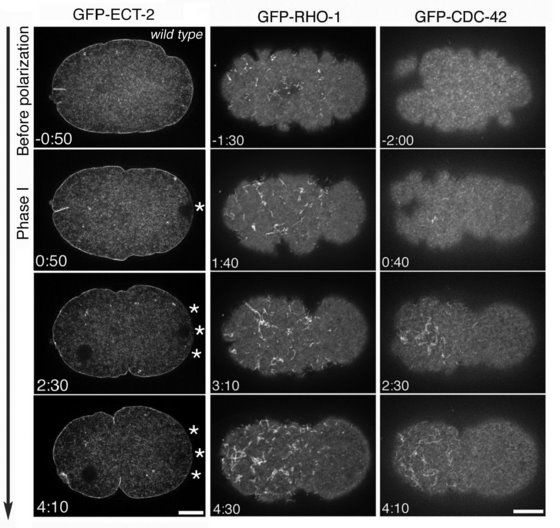Sep. 29, 2006 Research Highlight Biology
Poles apart: new mechanisms in cell polarity
Real-time visualization of cytoskeleton-associated proteins reveals their roles in the development and maintenance of cell polarity
 Figure 1: Anterior migration of fluorescently labeled ECT-2, RHO-1, and CDC-42 in a C. elegans embryo.
Figure 1: Anterior migration of fluorescently labeled ECT-2, RHO-1, and CDC-42 in a C. elegans embryo.
Researchers at the RIKEN Center for Developmental Biology in Kobe have identified important molecules that are essential for the establishment and maintenance of the anterior-posterior axis in the developing roundworm, Caenorhabditis elegans.
To develop a proper body plan, organisms must first establish an initial asymmetry. Asako Sugimoto, senior author of this new study1, explains that “to make various cell types, some cells have to produce two daughters that will have distinct cell fates. Breaking of symmetry in the mother cell is the first step in this process.”
Asymmetry first occurs when the sperm penetrates the egg, breaking its symmetry, and thus establishing a ‘pole’ within the one-celled embryo. Eventually a critical anterior-posterior (A-P) axis develops that allows future cell division to occur so that the worm can develop and mature normally. But, until now, it was unclear which molecules were important in establishing the A-P axis.
Sugimoto and her co-worker, Fumio Motegi, targeted three proteins (CDC-42, RHO-1, and ECT-2) associated with the cytoskeleton, since the cytoskeleton is important in the polarization process. Using a well-established genetic technique known as RNA-mediated interference (RNAi), they were able to eliminate the individual expression of each of these three proteins in newly fertilized C. elegans embryos.
The researchers then followed the motility of fluorescently-labeled proteins that were known to flow along the A-P axis to see how they behaved in the mutated embryos.
From these experiments, Sugimoto and Motegi were able to show that the A-P axis develops in two phases: in Phase I, RHO-1 and ECT-2 are required to establish the axis; while in Phase II, CDC-42 is required for its consolidation and maintenance. They then confirmed this finding by fluorescently labeling these three proteins and directly visualizing the dynamics and timing of their accumulation in the anterior pole (Fig. 1). Recent findings on the establishment of the A-P axis in C. elegans by two other groups2,3 are consistent with this study.
“Advancement of live-imaging techniques now enables us to examine highly dynamic cellular processes in live embryos and animals,” says Sugimoto. “And, the combination of live-imaging and RNAi techniques is a powerful tool to dissect dynamic processes at a genetic level.”
Sugimoto also thinks that it is highly likely that the mechanisms they have identified are also used in higher animals.
References
- 1. Motegi, F. & Sugimoto, A. Sequential functioning of the ECT-2 RhoGEF, RHO-1 and CDC-42 establishes cell polarity in Caenorhabditis elegans embryos. Nature Cell Biology 8, 978–985 (2006). doi: 10.1038/ncb1459
- 2. Jenkins, N, Saam, J.R. & Mango S.E. CYK-4/GAP provides a localized cue to initiate anteroposterior polarity upon fertilization. Science 313, 1298–1301 (2006). doi: 10.1126/science.1130291
- 3. Schonegg, S. & Hyman, A.A. CDC-42 and RHO-1 coordinate acto-myosin contractility and PAR protein localization during polarity establishment in C. elegans embryos. Development 133, 3507–3516 (2006). doi: 10.1242/dev.02527
